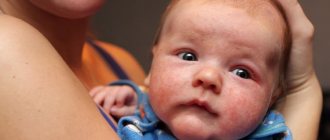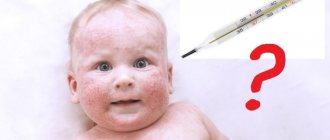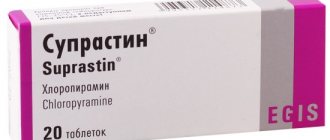The rash or redness first appears a couple of weeks after birth. The reaction is due to the presence of hormones that the newborn receives from the mother in the womb.
Spots of this kind quickly disappear. However, food allergies affect not only the condition of the skin, and therefore require treatment with diet or medication.
Symptoms of food allergies
Food allergies can be identified using characteristic symptoms. The disease affects the condition of the skin, intestines and respiratory organs, which does not have the best effect on the overall well-being of the baby.
The table shows the characteristic signs of food allergies.
| Leather | There is a rash, redness, blisters, itching, hives, diaper rash, prickly heat. Quincke's edema may appear. |
| Gastrointestinal tract | There is diarrhea, greenish feces, bloating, colic, vomiting, and frequent regurgitation. |
| Mucous membranes | Discharge from the nasal cavity, congestion, and sneezing appear. The allergy affects the mucous membrane of the respiratory tract, causing the baby to produce sputum, cough and wheeze. Sometimes the mucous membrane of the eyes is affected, which provokes the appearance of conjunctivitis. |
| General state | The baby has a poor appetite. The child is capricious, sleeps poorly, and cries often. |
Some symptoms are similar to those of other diseases. For example, a broken stool can be a companion not only to food allergies, but also to poisoning.
Only a pediatrician can make an accurate diagnosis.
Causes of food allergies in infants
The main cause of food allergies is weak immunity. The protective functions of an infant are not able to fully cope with harmful factors.
An allergy is a reaction of the immune system to an unfamiliar substance. That is why this response of the body appears more often in the first year of a child’s life.
Allergies can appear due to “bad” heredity. If parents are prone to allergic pathologies, there is a chance that the child will also be predisposed to them.
An allergic reaction in a baby occurs not only due to endogenous causes. The environment can also become an allergen. It can be caused by low-quality toys, paints, artificial building materials in the house, and dirty air.
Article on the topic: Allegard, a remedy for treating allergies with an individual composition
Main sites of allergy rash
How long do food allergies last in infants?
A couple of hours after consuming the allergen, redness appears on the baby’s skin. The intestines make themselves felt within one or two days.
By identifying and eliminating inappropriate products, the development of the disease can be prevented. The spots and allergic symptoms will disappear within the next few hours. But the intestines will need more time to recover - about 2-3 weeks.
The duration of a food allergy is influenced by the following factors:
- How much allergen entered the baby’s body;
- How quickly he was identified and expelled;
- How long or what day does a food allergy last?
- Is the course of treatment prescribed correctly?
- What is the state of the baby's immunity?
The baby's body does not accept chicken eggs, milk and brightly colored vegetables well. Intolerance to these foods often goes away on its own by age four.
However, an allergy to fish, for example, can last a lifetime. This is why they should not be included in a baby’s diet until they are eight months old.
Photo of food allergies in infants
Symptoms
Food allergy is manifested by a disorder of the internal organs and systems of the baby. Symptoms depend on the type of allergen, the volume entering the body, and the individual reaction.
The first alarming signs appear on the skin. Rashes and red spots appear on the baby’s body and face. The skin becomes dry and peels. This causes itching and discomfort.
Dyspeptic disorders are manifested by lack of appetite, excessive regurgitation, loose stools or constipation, vomiting, and increased flatulence. Babies are bothered by colic and frequent passing of gas.
With food allergies, infants experience respiratory symptoms: nasal congestion or severe runny nose with copious discharge of clear mucus, dry cough, sore throat, sneezing.
Food allergies can manifest as conjunctivitis, lacrimation, and photophobia. In especially difficult cases, the baby experiences an attack of bronchospasm, anaphylactic shock, and Quincke's edema.
The symptoms of an allergic reaction are quite acute and cause suffering to the baby. This negatively affects his emotional state, which leads to moodiness, irritability, apathy, and tearfulness. The child refuses to eat or play, suffers from insomnia or constant drowsiness.
How to treat food allergies?
Having discovered an allergy, the mother of a newborn or infant should not rush to switch to formulas and introduce them during the period when the disease manifests itself. First of all, you need to adjust the menu and adhere to a hypoallergenic diet.
You can get rid of food allergies only if you stop eating the product that caused such a reaction in the body. If it cannot be determined, all possible allergens are excluded for a couple of weeks. Then, little by little, every 2-3 days, they are introduced again one after another.
Sometimes drug treatment may be indicated for a baby. However, some drugs have side effects. Therefore, such medications should be used only on the recommendation of a doctor.
To relieve allergy symptoms, Enterosgel is prescribed; it cleanses and removes the allergen from the baby’s body. From one year of age you can use Fenistal, but it is not effective for extensive skin inflammation.
Urticaria on the face of a newborn
If there is conjunctivitis and tearing, the pediatrician may prescribe Zyrtec. After six months, Fenistil is prescribed, but it has side effects. For disorders of the gastrointestinal tract, the use of activated carbon is indicated.
You should not resort to using antihistamines. Such drugs quickly and effectively act on the skin of a baby affected by allergies, but the result is short-term.
Related article: What you need to know about skin testing for allergies in children
These include "Suprastin" and "Tavegil". Frequent use of these medications causes dizziness and lethargy.
For infants on artificial nutrition, it is necessary to carefully select formulas.
Such food should not contain cow's milk. Be sure to consult your doctor regarding the manufacturer you choose. Early complementary feeding can also cause allergies, and in general, it does not have the best effect on the baby’s development.
Types of food allergies in children
Drug therapy
The doctor prescribes treatment after examining and establishing the cause of the disease. Numerous medications are designed to alleviate the condition of the baby.
- Enterosorbents for removing toxins from the body, eliminating dyspeptic disorders (Enterosgel, Activated carbon).
- Creams, gels, ointments for the treatment of skin reactions (gel Fenistil, Zodak). They will help relieve itching, inflammation, redness, and eliminate rashes.
- Eye drops for conjunctivitis (Zyrtec is prescribed for newborns, Fenistil for older children).
- Medicines against allergic rhinitis (Nazivin, Vibrocil).
- Antihistamines to relieve symptoms (Suprastin, Zyrtec, in particularly difficult cases - Diphenhydramine).
What could be an allergen?
As mentioned above, allergies are most often caused by milk and chicken eggs. However, this is not the entire list of foods that the baby’s body cannot tolerate.
Let's look at the foods that most often cause a negative reaction:
- Whole milk;
- Porridge with milk;
- Mushrooms;
- Chicken and chicken eggs;
- Chocolate and other similar sweets;
- Nuts;
- Black tea, coffee;
- Vegetables and fruits of bright color, citrus fruits;
- Fatty fish;
- Pickles, marinades, hot spices;
- Onion and garlic;
- Foods and drinks containing dyes;
- Carbonated drinks and alcohol;
- Fast foods.
When following a hypoallergenic diet, you must avoid fried and smoked foods. Avoid spicy and very fatty foods. Limit the consumption of processed foods and foods containing chemical additives. It is important to drink 2-3 liters of water per day.
Consider the list of foods you can eat:
- Natural low-fat fermented milk products (sour cream, yogurt, cottage cheese);
- Porridge: buckwheat, oatmeal, polenta;
- Hard low-fat cheeses;
- Fruits and vegetables are not brightly colored;
- Lean meat and fish (pike perch, hake, turkey or beef, chicken is contraindicated) and broths based on them;
- Green tea, water.
You can't resort to regular diets to lose weight.
The daily menu of a nursing mother should contain a complex of vitamins and healthy components. You need to eat a little of everything: apples, milk, meat, cereal.
Allergy prevention
In the first month, the mother of the baby should follow a hypoallergenic diet. Sometimes it is necessary to follow this diet for 2-3 months. When the child’s body has adapted, other foods can be introduced into the diet. During this period, you need to closely monitor whether allergy symptoms arise.
It is better to consume new food from the third month of a baby’s life.
You need to start with small portions; if there are signs of food allergies, the product is removed from the diet. It should be reintroduced gradually, after 3-4 weeks. You shouldn't eat several new foods at once. If allergies occur, it will be difficult to find out which of them caused the irritation.
Try to stick to breastfeeding for as long as possible.
When artificial feeding, choose the mixture carefully; it should be hypoallergenic. It is better to start the first complementary foods after six months. To avoid an allergic reaction, it is recommended to first give vegetable puree or kefir.
Article on the topic: Perioral dermatitis - what is this disease and how to get rid of it?
It is equally important to lead an active lifestyle with your baby. Do exercises, walk more in the air, swim. This will help strengthen the body's protective functions and improve the child's overall health.
It is easy for a mother to protect her baby if she knows what happens after eating prohibited foods and what a food allergy looks like. You should not get rid of breastfeeding just because you are afraid of the occurrence of such a disease.
Allergenic foods for children during complementary feeding
The most allergenic product, according to doctors and according to the table of allergenic products for children, is cow's milk . In almost 80% of cases, it is not perceived by the child’s body. A similar reaction can be noticed when this product is introduced into the diet of children under one year old. However, this does not mean that in the future the child will have to completely stop taking this product. The body will be ready to properly process milk protein only after 2 years. You need to be careful when choosing formula milk. It is also worth giving up foods such as sesame, cheese, wheat, spices, and exotic fruits .
Doctors advise not to refuse the introduction of fish and eggs. Allergies can be caused, for the most part, by fatty fish and only egg yolk.
It is recommended to exclude caviar , canned fish and other seafood from the diet.
When introducing meat, you should give preference to beef, rabbit, horse meat, and turkey. In children who are especially prone to allergies, beef can cause an allergic reaction. But it’s better to exclude the familiar chicken, like chicken broth.
Highly allergenic berries include wild strawberries, strawberries, cherries, grapes, sea buckthorn and raspberries. White currants, gooseberries and white cherries are not dangerous. Other types of berries should be given carefully. Along with citrus fruits, apricots, melons, peaches, all types of tropical fruits, persimmons, pomegranates, dried fruits and red apples are highly allergenic. In terms of vegetables , you should limit yourself to potatoes, white cabbage, zucchini, fresh cucumbers, and herbs. It is allowed to introduce fermented milk products, butter in small quantities and mild types of cheese.











